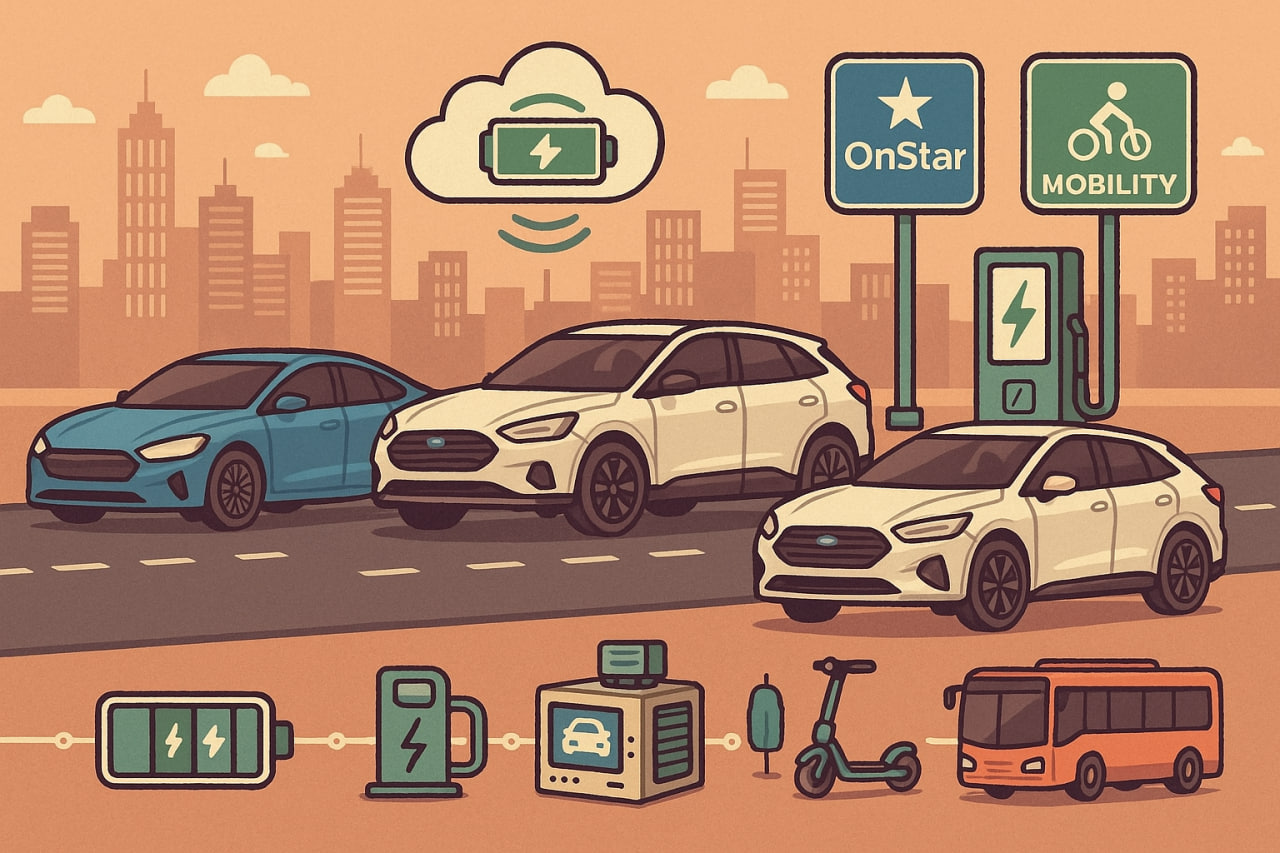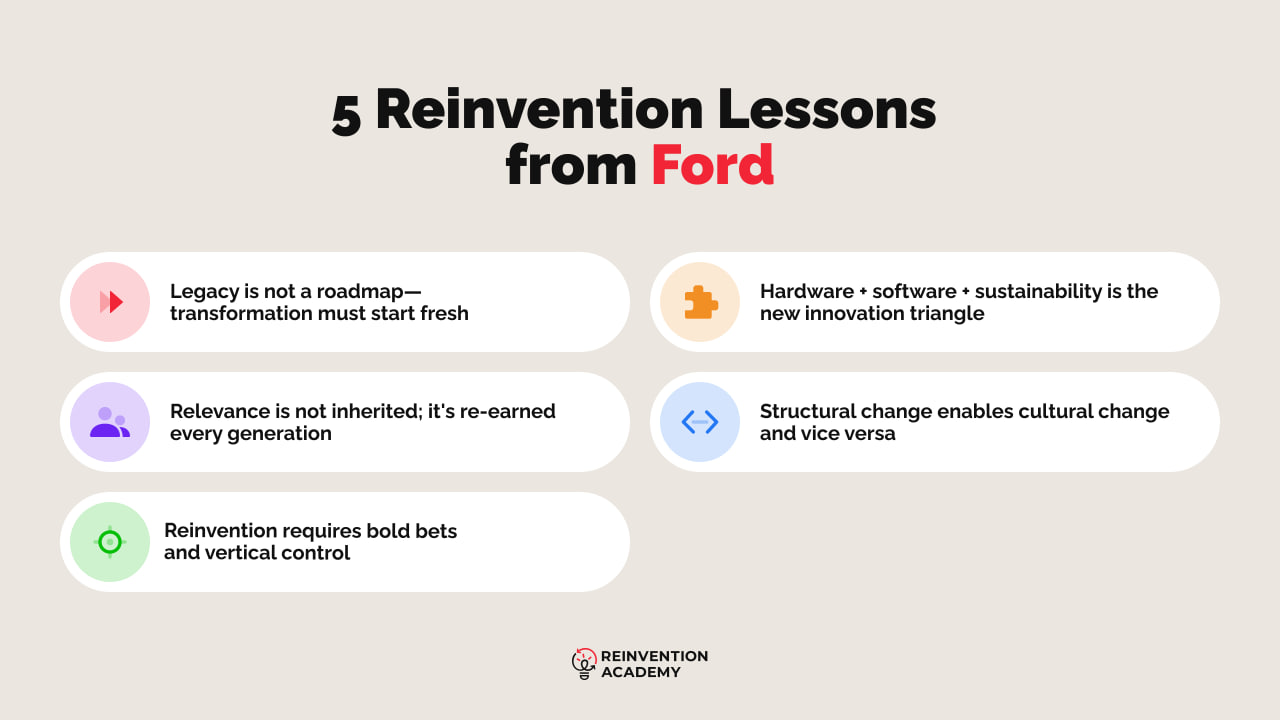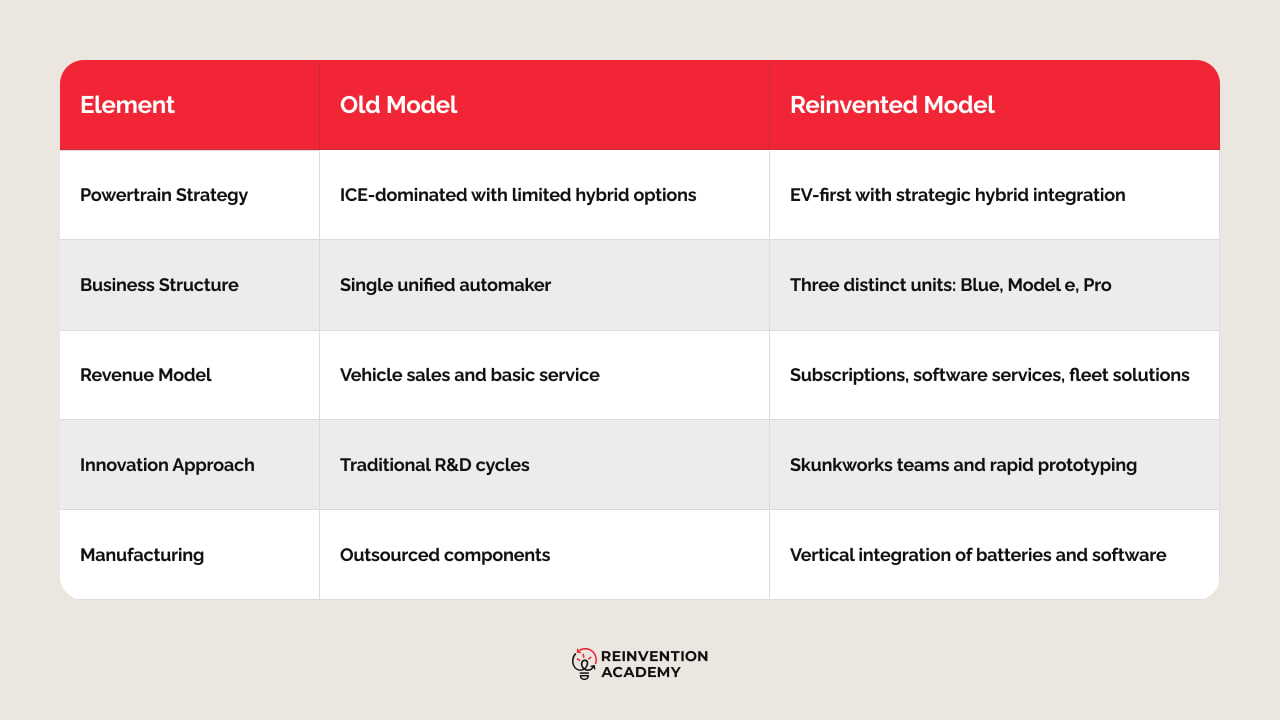Shifting Into Drive: How Ford Reinvented Itself from an Automaker to a Mobility Platform
Ford’s transformation from traditional automaker to electric mobility leader through strategic reinvention, digital transformation, and bold changes.

Ford Motor Company is a global automotive manufacturer founded in 1903 and headquartered in Dearborn, Michigan. The company designs, manufactures, and sells trucks, SUVs, cars, and commercial vehicles under the Ford and Lincoln brands. In 2024, Ford reported $185 billion in revenue (up 5% from 2023) and employs approximately 170,000 people worldwide.
The Ford case study shows how legacy automakers can reinvent themselves when facing existential threats from Tesla, Chinese EV manufacturers, and changing customer expectations. Dr. Nadya Zhexembayeva calls this type of change "strategic reinvention," and Ford is proving that even the biggest industrial giants can learn new tricks.
Why Ford Needed Reinvention
Tesla's market leadership had fundamentally reshaped customer expectations around software-first vehicles. People wanted cars that updated like smartphones and felt more like computers on wheels. Meanwhile, ESG investors and regulators kept pushing harder for cleaner vehicles. Ford's customer base was aging out, too. Young buyers gravitated toward brands that aligned with their values around sustainability and technology.
The automaker faced a brutal reality check. Ford's Model e division (its EV unit) lost $5.1 billion in 2024, with projections showing continued losses of $5-5.5 billion through 2025. That's a tough pill to swallow when you're trying to compete with profitable EV companies.
Chinese manufacturers were also playing an entirely different game. They built electric vehicles with cost structures that Ford couldn't match, leveraging vertical integration and advanced battery technology. The competition wasn't just better cars. They were rewriting the rules of what cars could be.
Ford's Reinvention Strategy: Electric, Agile, and Always Connected
Ford had to dismantle 120 years of automotive orthodoxy in three ways to bring their transformation to life.
1. Driving Electrification
Ford has committed over $30 billion in EV investments through 2025, but they've learned some expensive lessons along the way. The company initially planned to spend 40% of capital expenditure on pure electric vehicles. They've now scaled that back to 30%, focusing on profitable, affordable EVs starting in 2026.
BlueOval City in Tennessee will start producing battery cells in late 2025, supporting Ford's new electric commercial van and future vehicles. The facility represents a massive bet on American EV manufacturing. Ford is also building BlueOval Battery Park in Michigan, America's first automaker-backed lithium-iron phosphate battery plant.
Despite facing financial challenges, Ford achieved record EV sales in 2024 with 285,291 units sold, representing a 38% increase from the previous year. The Mustang Mach-E, F-150 Lightning, and E-Transit are becoming more popular in the market, even if profitability remains elusive.
2. Software and Vehicle Intelligence
Ford Model e division isn't just building electric cars. They're developing software-defined vehicles (SDVs) that can generate revenue through digital services and over-the-air updates.
Doug Field, Ford's chief EV and digital systems officer (recruited from Apple), leads the division's product development. The company focuses on embedded software that creates exceptional digital experiences. It has partnered with Google Cloud for AI-driven features and shifted to a cloud-first strategy.
Ford developed the Ford Pro API, making data from connected commercial vehicles available for internal and partner applications. This creates a software-as-a-service revenue stream, transforming Ford Pro into both a vehicle manufacturer and a digital services provider.
3. Restructuring the Business Model
Ford split into three distinct business units in 2022:
- Ford Blue: Traditional internal combustion and hybrid vehicles
- Ford Model e: Electric vehicles and digital technologies
- Ford Pro: Commercial vehicles and fleet services
Each division operates with its own financial statements but shares relevant technologies and best practices. This structure allows Ford to optimize each business for its specific market while maintaining operational synergies.
The Ford Pro division has become a standout performer, offsetting billions in EV losses through its commercial vehicle and fleet services business. Ford is transitioning from selling vehicles to selling mobility solutions, subscriptions, and ongoing services.
Two Enablers That Made Reinvention Real
Ford's transformation required more than new products and different business units.
1. Cultural Modernization and Leadership Change
Jim Farley brought the urgency that Ford desperately needed. Under his leadership, Ford has embraced a "startup within a legacy" mindset, flattening hierarchy and empowering innovation teams.
Farley learned from veteran employees that young workers were leaving Ford due to low wages, with some taking shifts at Amazon to make ends meet. He responded by raising wages and converting temporary workers to full-time employees, following founder Henry Ford's 1914 strategy of paying workers enough to buy Ford products.
The cultural shift shows up in product development timelines. Farley noted that the new Maverick hybrid pickup truck's launch process was 20 months shorter than it might have been several years ago. "The culture is starting to change," he said.
2. Vertical Control of EV Infrastructure
Ford concluded early it couldn't rely on anyone else for key electric vehicle parts. The company revised its U.S. battery sourcing strategy to enhance cost savings and capacity utilization, meeting current and future electric vehicle production plans.
Ford stands to gain considerable impact and sourcing flexibility by adopting this common cell strategy for manufacturing in various segments and electrified platforms as the market evolves. Instead of outsourcing the EV platform to tech companies, Ford designed it internally to retain control and IP quality.
The vertical integration extends beyond batteries. Ford is developing its own software stack, manufacturing capabilities, and even semiconductor partnerships to reduce supply chain vulnerabilities.

Dr. Nadya Zhexembayeva's Reinvention Lens on Ford
Ford's reinvention strategy perfectly demonstrates Dr. Nadya Zhexembayeva's framework for strategic organizational change.
Ford demonstrates full-spectrum reinvention where culture, products, value creation, and organizational structure evolve simultaneously. The company successfully:
- Let go of its overdependence on internal combustion engines and traditional dealer-centric sales models
- Aligned with future-forward technologies, sustainability requirements, and software-driven customer experiences
- Embedded innovation into production workflows, leadership structures, and cross-functional collaboration
- Created a hybrid identity that combines automaker heritage with technology company capabilities and sustainability leadership
Ford didn't just build electric cars. They rebuilt what it means to move people and goods in the 21st century.
5 Reinvention Lessons from Ford for Business Leaders
- Legacy is not a roadmap—transformation must start fresh. Ford's 120 years of manufacturing expertise became a constraint rather than an advantage when building EVs. The company had to abandon traditional automotive development processes and create new approaches for software-defined vehicles.
- Hardware + software + sustainability is the new innovation triangle. Ford's investment in battery manufacturing, software development, and carbon reduction goals shows that modern automotive companies must excel across all three dimensions simultaneously, not just mechanical engineering.
- Structural change enables cultural change and vice versa. Creating separate business units (Ford Blue, Model e, Pro) allowed each division to develop appropriate cultures and operating models without legacy constraints. The organizational restructuring enabled the cultural modernization that Jim Farley championed.
- Reinvention requires bold bets and vertical control. Ford is willing to lose billions in EV development while at the same time building out internal battery and software capabilities, indicating long-term competitive thinking rather than short-term profitability.
- Relevance is not inherited; it's re-earned every generation. Ford amended its EV strategy based on the observation that consumers were more cost-sensitive and range-anxious than they had presumed. In other words, even iconic brands must learn to demonstrate their worth to new customer segments.
Ford Reinvention at a Glance

Final Gear: Why Ford's Reinvention Still Has Traction
Ford’s transformation shows that businesses in industrial sectors can achieve turnarounds without departing from their roots. The automaker shows that legacy can be a launchpad, not a limitation, when leaders stick their necks out.
Business leaders in the same boat must ask themselves whether they modify their current model or whether they build a new one. Will we solve problems of the future or will we optimize the solutions of the past?
Ford plans to keep pouring funds into electrification with updates on technologies, profitability, and capital needs in the first half of 2025. Meanwhile, Ford’s auto digital transformation is underway as circumstances change in the market.
As Dr. Nadya Zhexembayeva reminds us, “Reinvention is not a destination; it’s a capability.” The Ford reinvention strategy shows us that the companies that survive disruption are those that can constantly renew themselves, treating each challenge not as a threat to their legacy but as an invitation to build their future.


.svg)